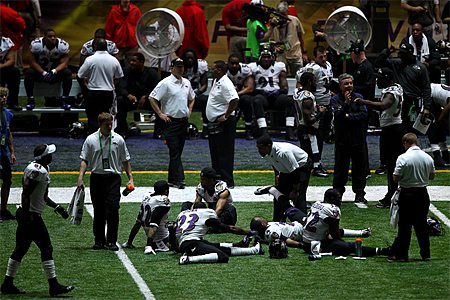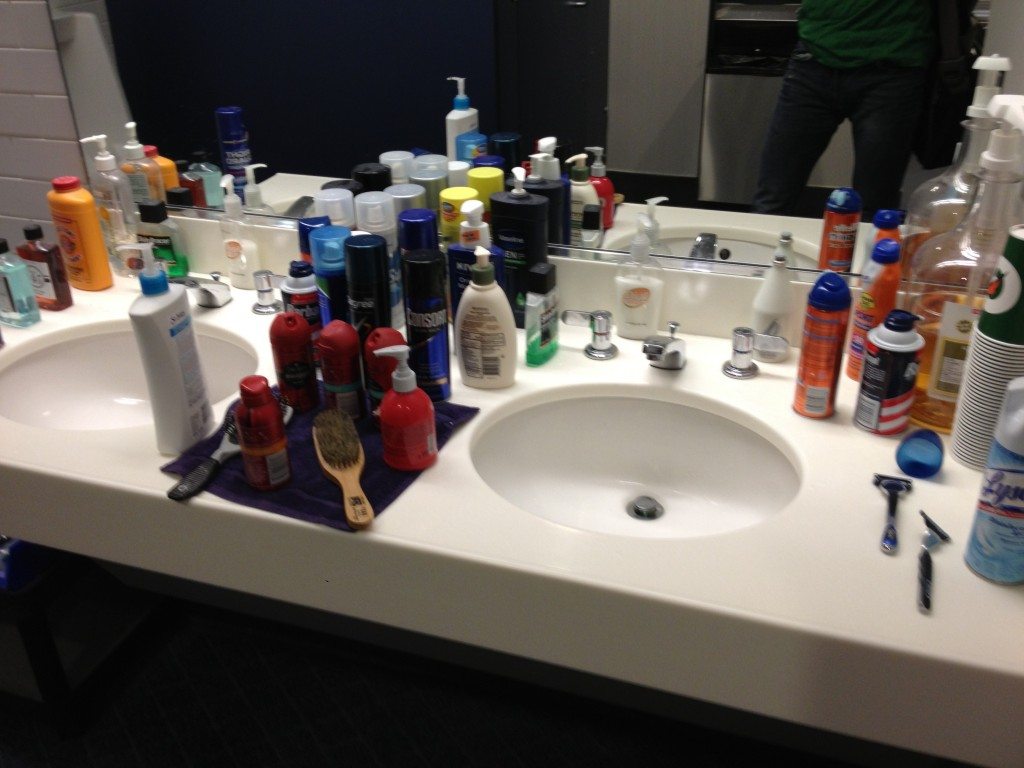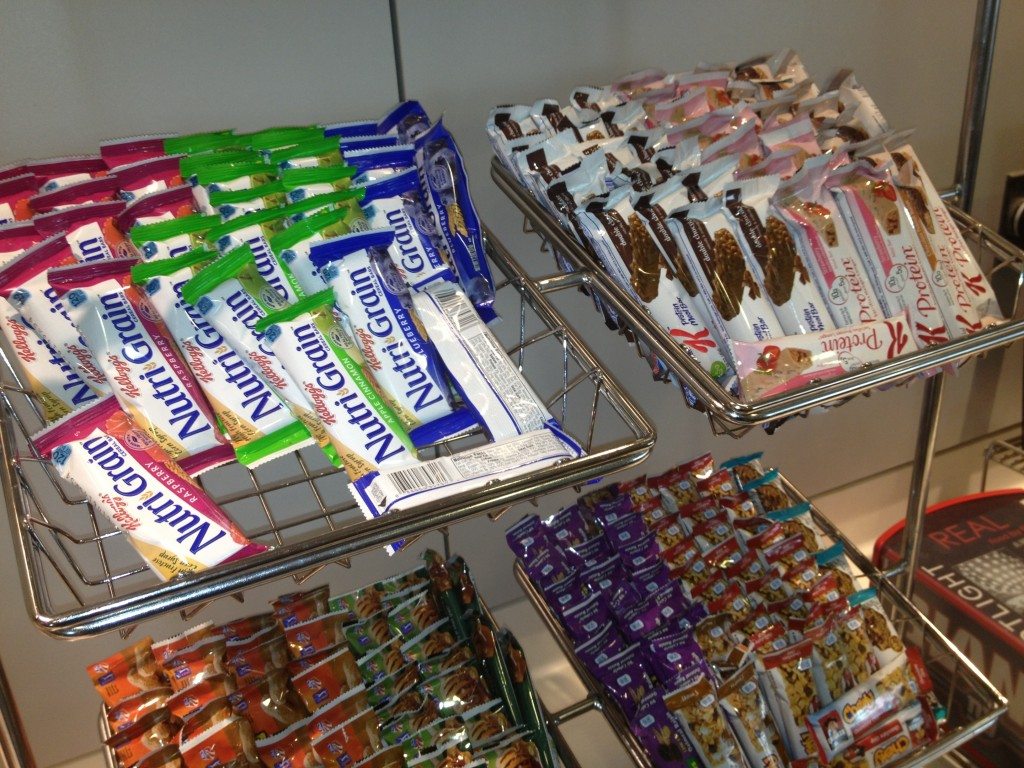February 18, 2013
Since I race as a triathlete for Team Timex, I spent my entire last weekend in New York at the Timex Performance Center – which is where the professional football team New York Giants eat, train and play.
And I was able to witness firsthand many of the training, nutrition and recovery protocols that are at the disposal of professional athletes.
So do professional sports teams have it all wrong when it comes to optimizing performance and recovery?
Not necessarily.
But there are definitely some important advantages being “left on the table” when it comes to helping players bounce back faster from injuries, stay lean and muscular, and perform at their peak capacity – and certainly some things that I'd do differently if I ran a pro sports team.
Here are the top 7 things I'd change if I managed a pro sports team:
1. Get Rid Of Endocrine Disruptors
Here's a photo I shot of one sink in the Giant's locker room:
I simply do not understand why a professional football player who is attempting to maximize free testosterone would instead slather and soak their body in endocrine disruptors that cause testosterone conversion in estrogens, man-boobs, low drive and competitive drive and a host of other chemical driven issues that I talk about in this blog post on the dangers of many personal care products and cleaning chemicals.
Instead of a fragrant, chemical cocktail of lotion, why not just use emu oil or olive oil?
Instead of aerosol-based, aluminum deodorant, why not just use a chemical-free alternative?
Instead of having freaking Lysol and anti-bacterial sprays all over the locker room, why not just have an essential oil solution?
I know I sound like an old hippie on a mountain, but I know I can't be the only one seeing a problem here….
—————————————
 2. Stretch The Right Way
2. Stretch The Right Way
Remember when the lights went out during this year's Super Bowl XLVII? During that long break, you saw teams like the Ravens (pictured right) doing long bouts of static stretching.
That's about the worst form of stretching you can do to maximize power and enhance performance.
While they could have easily been implementing dynamic stretching or resistance stretching, these professional trainers and coaches had their athletes simply laying there doing stretches that sports scientists have known for over a decade will reduce a muscle's force potential.
Static stretching doesn't work, and the only thing I'd use it for with a professional athlete would be relaxation and stress relief. In other words, it's a better bedtime routine than a pre-game ritual, but many pro sports teams see to be stuck in the past when it comes to stretching.
—————————————
3. Have Better Anti-Inflammatories
The week prior to camp, I tore my pec muscle while snowboarding , and it was still sore and painful when I arrived at camp, so I went into the athletic training room in search of some kind of anti-inflammatory or topic solution.
But all they had was Advil and Tiger Balm.
You can read about the dangers of Advil here, and when there are 100% natural compounds such as high dose turmeric, nattokinase, ginger extract, tart cherry and a plethora of other pain-killing cocktails that don't kill your liver and gut, it simply doesn't make sense for a professional athlete to dump pharmaceutical anti-inflammatories into their body. When I'm injured, I do 12 Capraflex and 8 Phenocane a day and it works fast for both pain and healing
And frankly, compared to topical anti-inflammatories that actually help an injury to heal, such as transdermal magnesium or Traumeel, Tiger Balm is just a temporary bandaid.
—————————————
4. Include All Available Therapeutical Modalities
When I went into the athletic training room to ask whether they had any cold laser I could use on my torn pec, the answer was no. I certainly saw ultrasound, electrostimulation, and what I believe were the equivalent of GameReady ice/compression recovery leggings, but if I managed a pro sports team, I'd also have:
–portable electrostimulation units for players to use during classes
–cold low level laser and/or infrared units
–pulsed electromagnetic field therapy (PEMF)
This stuff is not expensive and would be easy to have around for players to use for enhancing recovery.
—————————————
5. Use Only The Best Fuel
I'll readily admit that the food in the Timex Performance Center is way above the standard of the typical cafeteria fare.
But despite an overall healthy appearance, with things like wild salmon, grass fed beef, an organic salad bar and lots of other healthy ingredients, there is also a lot of packaged crap (such as the photographs I took below) and I guarantee hungry athletes are eating it. Why not just keep things totally clean if you're looking for every possible performance and recovery advantage?
For example, in the top photo you see what is essentially liquid sugar: chocolate milk, flavored creamers and Gatorade G2. Follow those links to see why this is complete sludge for an athlete's body.
In the bottom photo, you see Nutrigrain bars, Kellogg's Bars and Quaker Oats bars – all sugar, wheat and GMO ingredient filled crap. Why not use Cocochia Bar, Hammer Recovery Bar, LaraBar, Nogii Bar, Quest Bar, Zing Bar, HealthWarrior Bar, BonkBreaker Bar or any other “clean” bar vs. this cheap, subpar packaged fuel?
I didn't even get to stuff like:
-Unsoaked, digestive enzyme inhibiting legumes…
-Roasted, high-free-radical containing seeds and nuts…
-Foods cooked in omega-6 laden vegetable oils…
And many other things that may not seem like a big deal unless you're a professional athlete trying to win a championship.
—————————————
6. Quantify Recovery Status
I could have totally missed it, but I did not see any mention or reference to heart rate variability (HRV) for quantifying nervous system overuse or recovery status – in the training room or anywhere else – and you rarely hear professional athletes or coaches talking about this extremely powerful method of assessing an athlete's status. A very simple 5 minute morning HRV measurement can easily predict an athlete's readiness to train, and can be implemented using any number of devices, including the Zensorium Tinke, Sweetbeat system, Bioforce or Omegawave.
And of course, HRV can also be used to better get athlete into the zone. Here's an anecdote from ESPN's I Think Therefore I Choke article:
“If you'd been watching (Raven's kicker) Cundiff on the sideline this past season, you'd have seen him toying with a silver gizmo the size of an iPod. Given to him the previous year by psychologist Louis Csoka, one of his mental trainers, it's known as an emWave, and it measures heart rate variability (HRV). Not beats per minute — that's old-school. Designed by the research company HeartMath, the emWave examines in real time how athletes are responding to old sports psychology tricks like visualization and meditative breathing. It's the same gizmo used by military elite tactical teams to regulate stress levels before deployment…”
—————————————
7. Reduce EMF Exposure
Electromagnetic Field (EMF) exposure is a huge barrier to performance and recovery, and from dirty electricity filters to low blue lights to installing Flux on athlete computers , there are very simple ways that a training center could mitigate an athlete's constant exposure to electrical pollution.
As a matter of fact, Jack Kruse, a brilliant neurosurgeon who was on this “How You Can Use Cold Thermogenesis To Perform Like Lance Armstrong And Michael Phelps” podcast episode with me, is currently writing an expose of how much we've been completely brainwashed into thinking computers, cell phones and other devices don't affect our biology and performance, and his latest treatise on this “What Are The Biologic Effects of EMF?” should be a must-read for any coach, trainer or athlete serious about taking things to the next level and getting every little advantage possible.
—————————————
I've really only scratched the surface on the details behind this stuff, and while this wasn't meant to be a peer-reviewed journal article, I at least wanted to open the discussion about whether pro sports teams are really pulling out all the stops when it comes to success and winning championships.
And I really think there's a lot being left on the table.
What do you think? Am I just a silly guy who shouldn't be critiquing a world championship winning football team? Or could they be taking even better care of players with the millions of dollars at their disposal?





The players are the teams investment. With that being said, all measures should be taken to optimize the players health. Instead of sponsors like Gatorade, why not coconut water? I know Gatorade is hugely invested in the NFL but what’s more important, the players health or money? It’s little changes like this that make all the difference. Thank you Ben for shedding light on some of the overlooked truths in today’s sports.
Ben, why aren't you recommending Chocolate Milk as a recovery drink? The link you provided doesn't work. Would like to hear your thoughts.
Which link didn't work, Ryan? Read the book "Whitewash": http://www.eatdrinkpolitics.com/wp-content/uploads/SimonWhitewashedDairyReport.pdf.
Hey mate, thanks for replying. Just the link in the section where you observed they had Chocolate milk, Gatorade and flavoured creams
Let's see…
World Championship professional football team with a Billion dollar payroll, able to buy the most cutting edge everything, able to staff the foremost experts in every field…vs. Ben Greenfield.
While I'm absolutely certain that they aren't doing everything right, I'm also absolutely certain that you over-state some things sometimes, Ben.
Sorry. I'm gonna have to sit this circle circus out. Guess I haven't had quite enough kool-aid.
It's crazy that they have so much money and nobody there that knows this stuff. I hope you got through to them – I like the Giants.
Really? An online nutritionist-entreprenuer vs. NFL. I like Ben…a lot…but he doesn't have all the answers…and he's not always right…and I'm pretty sure he doesn't crap golden eggs. (Although, if I'm wrong on that last one, Ben…I take it all back!)
I strongly suggest all of you to read Dr. Jack Kruse blog. He is one of few EMF experts and maybe only one that explains with great detail EMF negative effects at cellular level.
great, great article! unfortunately, most of the top level teams in different sports are not very far from this situation you've presented. The pic with the guy "sprinting" wraps it up, big time!
in the light of JK's blog and his comments on pulsed emf, i'm a little confused. is it really therapeutic?
Yes, it can be used for both performance or for recovery. It just depends on the frequency and amplitude you use.
Hi Ben, good article. Re: your first point on endocrine disruptors, do you have any recommendations for a high quality, natural shaving cream? Thanks!
Chec http://www.greenshave.com/
I think your doing the right thing. I have a couple questions though, were you able to interview any of the players to find out what they thought about the subject? What do they eat and drink at home? What treatments do they use for recovery. With the excessive salary they make they should be able to afford the very best.
Most of the players aren't around this time of year, Brian. It's mostly just us triathletes. ;)
Good post Ben!
It's ironic that these teams have almost unlimited resources at their disposal and yet they still make some of the most fundamental mistakes when it comes to maintaining the health of their athletes.
I think the best solutions to problems come from pooling information sources by putting individuals who are experts in various fields in the same room to work on them or by tapping into the knowledge base of open-minded individuals who have training in multiple fields. Self-experimentation and real testimonials are also a big help. So, I don't think critiquing a professional athletic team is silly. The powers-that-be are so often affected by pride and ego, cost, sponsors and shareholders, etc., that pure information and simple truths are easily obscured. Having someone like you that has training in and exposure to a variety of fields critique the program only makes good sense.
Not silly – PRO anything is about RIGHT NOW and not in a Eckhart Tolle type of way. Your suggestions are proven to be about sustainable health and long term energy without inefficient breakdowns and substantial stress on the body. They will do anything to get a quick fix even if it means a paralyzed future. Even with something as simple as "Just cover the stink with whatever no matter how harmful" (#1) instead of realizing you stink so bad because of what you are putting in your body oozing out your pores in bacteria and toxins the body can't break down. Ok,enough preaching – good article. I enjoyed it
Good point, especially about that "stank", Joe!
Ben do you recommend the zensorium tinke, omegawave or the sweetbeat system if you had to choose 1?
I haven't decided yet! None are ideal honestly, because it would be nice of ONE watch that was small and portable did all this stuff. But so far, Tinke is easiest and most intuitive, if you have an iPhone.